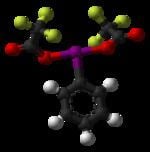Formula C10H5F6IO4 | ||
 | ||
(Bis(trifluoroacetoxy)iodo)benzene, C
6H
5I(OCOCF
3)
2, is a hypervalent iodine compound used as a reagent in organic chemistry. It can be used to carry out the Hofmann rearrangement under acidic conditions.
Contents
Preparation
The syntheses of all aryl hypervalent iodine compounds start from iodobenzene. The compound can be prepared by reaction of iodobenzene with a mixture of trifluoroperacetic acid and trifluoroacetic acid in a method analogous to the synthesis of diacetoxyiodobenzene:
It can also be prepared by dissolving diacetoxyiodobenzene (a commercially-available compound) with heating in trifluoroacetic acid:
Uses
It also brings around the conversion of a hydrazone to a diazo compound, for example in the diazo-thioketone coupling. It also converts thioacetals to their parent carbonyl compounds.
Hofmann rearrangement
The Hofmann rearrangement is a decarbonylation reaction whereby an amide is converted to an amine. It was first reported by August von Hofmann in 1881, and is usually carried out under basic conditions where the reaction proceeds via an isocyanate intermediate.
The reaction can also be carried out under acidic conditions using a hypervalent iodine compound. An example published in Organic Syntheses is the conversion of cyclobutylcarboxylic acid to the hydrochloride salt of cyclobutylamine. The carboxylic acid reacts with methyl chloroformate in the presence of N-methylmorpholine to form a carbonate intermediate from which the primary amide is derived. The hypervalent iodine compound allows the Hofmann rearrangement in acidic conditions, leading to the primary amine product being recovered as a salt.
